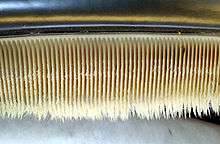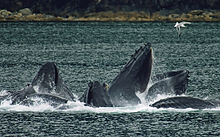Mysticeti
Appearance

Megaptera novaeangliaeex aequore erumpit






Mysticetisuntparvordomammalium marinoruminfraordinisCetaceorum,late distributus variusquecarnivororumgrex.FamiliasBalaenidarum,Balaenopteridarum,Cetotheriidarum,etEschrichtiidarumcomprehendunt. Sunt quindecim Mysticetorumspeciesvivae. Mysticeti abodontocetisabhinc annorum 34 milliones fere deflexerunt.
Magnitudinevariant a 6 metra et 3000 kg ponderis (Caperea marginata)ad 31 metra et 190 megatonnae ponderis (Balaenoptera musculus), maximumanimalnotum quod umquam existit.[1][2]
Taxinomia
[recensere|fontem recensere]Mysticeti in quattuorfamiliisexstantibus consistunt, quae suntBalaenidae,Balaenopteridae,Cetotheriidae,Eschrichtiidae.
Classificatio
[recensere|fontem recensere]- Parvordo Mysticeti
- †Coronodon
- Familia †Aetiocetidae[3]
- †FamilyLlanocetidae
- †FamiliaMammalodontidae
- †FamiliaMystacodontidae
- CladusChaeomysticeti
- †Horopeta
- †Sitsqwayk
- †Whakakai
- SuperfamiliaEomysticetoidea
- †FamiliaCetotheriopsidae
- †FamiliaEomysticetidae
- CladusBalaenomorpha
- SuperfamiliaBalaenoidea
- CladusThalassotherii
- †Hibacetus
- †Isocetus
- †Parietobalaena
- †Isanacetus
- †Mauicetus
- †Pinocetus
- †Taikicetus
- †Tiphyocetus
- †Uranocetus
- Familia †Aglaocetidae
- †FamiliaDiorocetidae
- †FamiliaPelocetidae[3]
- †FamiliaTranatocetidae
- FamiliaCetotheriidae
- FamiliaNeobalaenidae
- SuperfamiliaBalaenopteroidea
- †Eobalaenoptera
- FamiliaBalaenopteridae[5]
- FamiliaEschrichtiidae[7]
- †Archaeschrichtius
- †Eschrichtioides
- Eschrichtius
- †Gricetoides
- †Megapteropsis(nomen dubium)[3]
- incertae sedis
- Amphiptera
- †Halicetus
- †Imerocetus
- †Mioceta(nomen dubium)[3]
- †Piscocetus
- †Siphonocetus(nomen dubium)[3]
- †Tretulias(nomen dubium)[3]
- †Ulias(nomen dubium)[3]
Notae
[recensere|fontem recensere]- ↑Paul, Gregory S. (25 Octobris 2016). [(TextusapudGoogle Books)The Princeton Field Guide to Dinosaurs] (Second ed.). Princeton University Press. p. 19.ISBN978-1-4008-8314-1.
- ↑Bortolotti, Dan (14 Octobris 2008). [(TextusapudGoogle Books)Wild Blue: A Natural History of the World's Largest Animal]. St. Martin's Press.ISBN978-1-4299-8777-6.
- ↑3.03.13.23.33.43.53.6Marx, Felix G. (2011). "The More the Merrier? A Large Cladistic Analysis of Mysticetes, and Comments on the Transition from Teeth to Baleen".Journal of Mammalian Evolution18(2): 77–100.
- ↑Marx, Felix G.; Tsai, Cheng-Hsiu; Fordyce, R. Ewan (2015)."A new Early Oligocene toothed 'baleen' whale (Mysticeti: Aetiocetidae) from western North America: one of the oldest and the smallest".Royal Society Open Science2(12): 150476.
- ↑Deméré, Berta & McGowen 2005.
- ↑Steeman, M. E. (2010). "The extinct baleen whale fauna from the Miocene–Pliocene of Belgium and the diagnostic cetacean ear bones".Journal of Systematic Palaeontology8(1): 63–80.
- ↑Marx, Felix G.; Fordyce, R. E. (2015)."Baleen boom and bust: a synthesis of mysticete phylogeny, diversity and disparity".Royal Society Open Science2(4): 140434Formula:Open access.
Bibliographia
[recensere|fontem recensere]- Bannister, John L.2008.Baleen Whales (Mysticetes). InEncyclopedia of Marine Mammals,ed. William F. Perrin, Bernd Würsig, et J. G. M. Thewissen, 80–89. Academic Press.ISBN 978-0-12-373553-9.
- Cavendish, Marshall (2010). [(TextusapudGoogle Books) "Gray whale" ].Mammal Anatomy: An Illustrated Guide.Marshall Cavendish Corporation.ISBN978-0-7614-7882-9
- Cope, E. D.(1891)."Syllabus of Lectures on Geology and Paleontology".Ferris Brothers.p. 69
- Deméré, T. A.; Berta, A.; McGowen, M. R. (2005). "The taxonomic and evolutionary history of fossil and modern balaenopteroid mysticetes".Journal of Mammalian Evolution12(1): 99–143
- Feldhamer, George A.; Drickamer, Lee; Vessey, Stephen C.; Merritt, Joseph H.; Krajewski, Carey F. (2015). [(TextusapudGoogle Books) "Cetacea" ].Mammalogy: Adaptation, Diversity, Ecology.Johns Hopkins University Press.ISBN978-1-4214-1588-8
- Rice, Dale W.1998.Marine mammals of the world: systematics and distribution.Society for Marine Mammalogy1–231. OCLC 40622084.
- Tinker, Spencer W.1988.Whales of the World.Brill Archive.ISBN 978-0-935848-47-2.
- Uhen, M. D.2010.The Origin(s) of Whales.Annual Review of Earth and Planetary Sciences38 (1): 189–219. doi:10.1146/annurev-earth-040809-152453. Bibcode 2010AREPS..38..189U.
Nexus externi
[recensere|fontem recensere]| Vicimedia Communiaplura habent quae adMysticetosspectant. |
| Vide"Mysticetos"apudVicispecies. |
